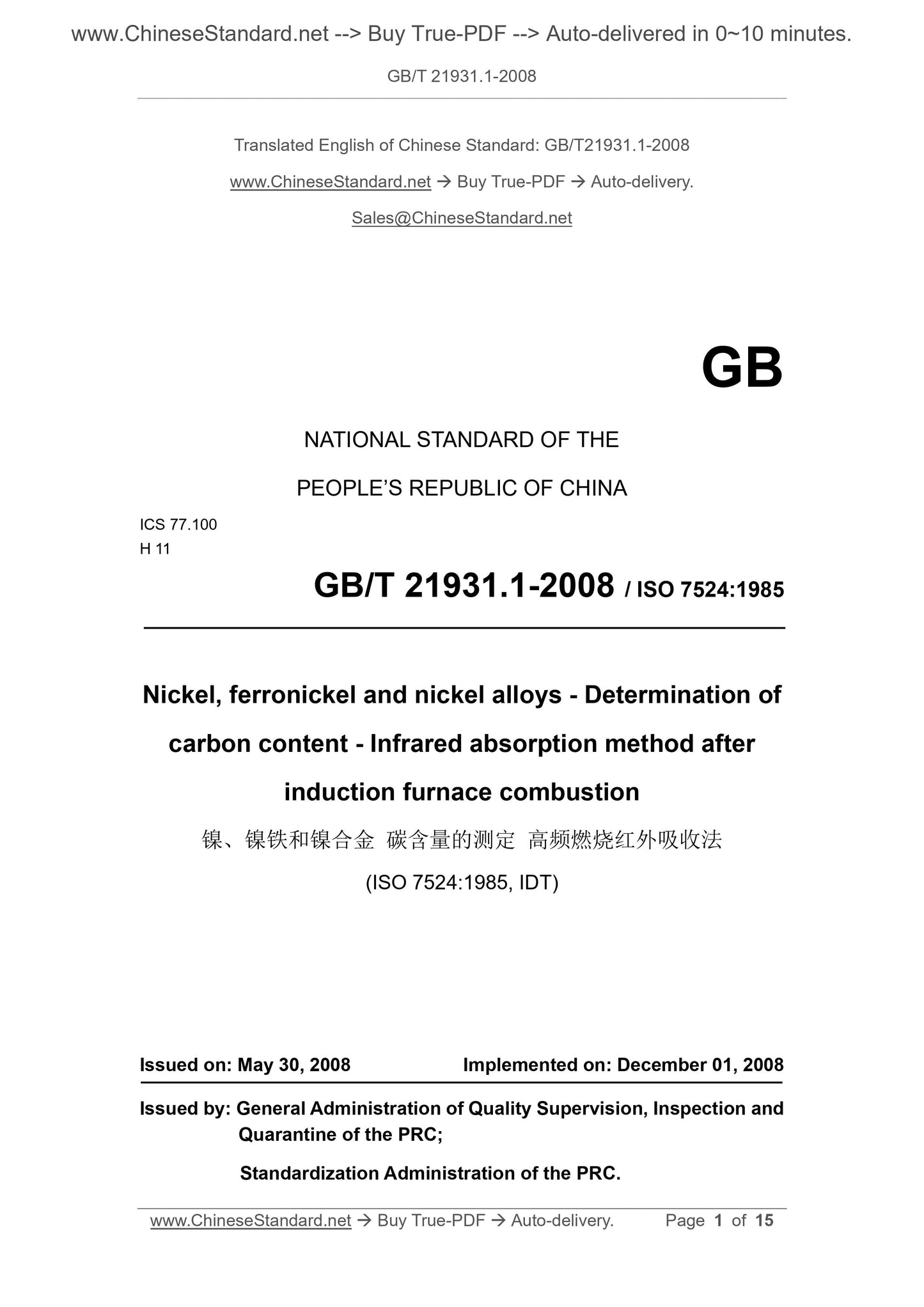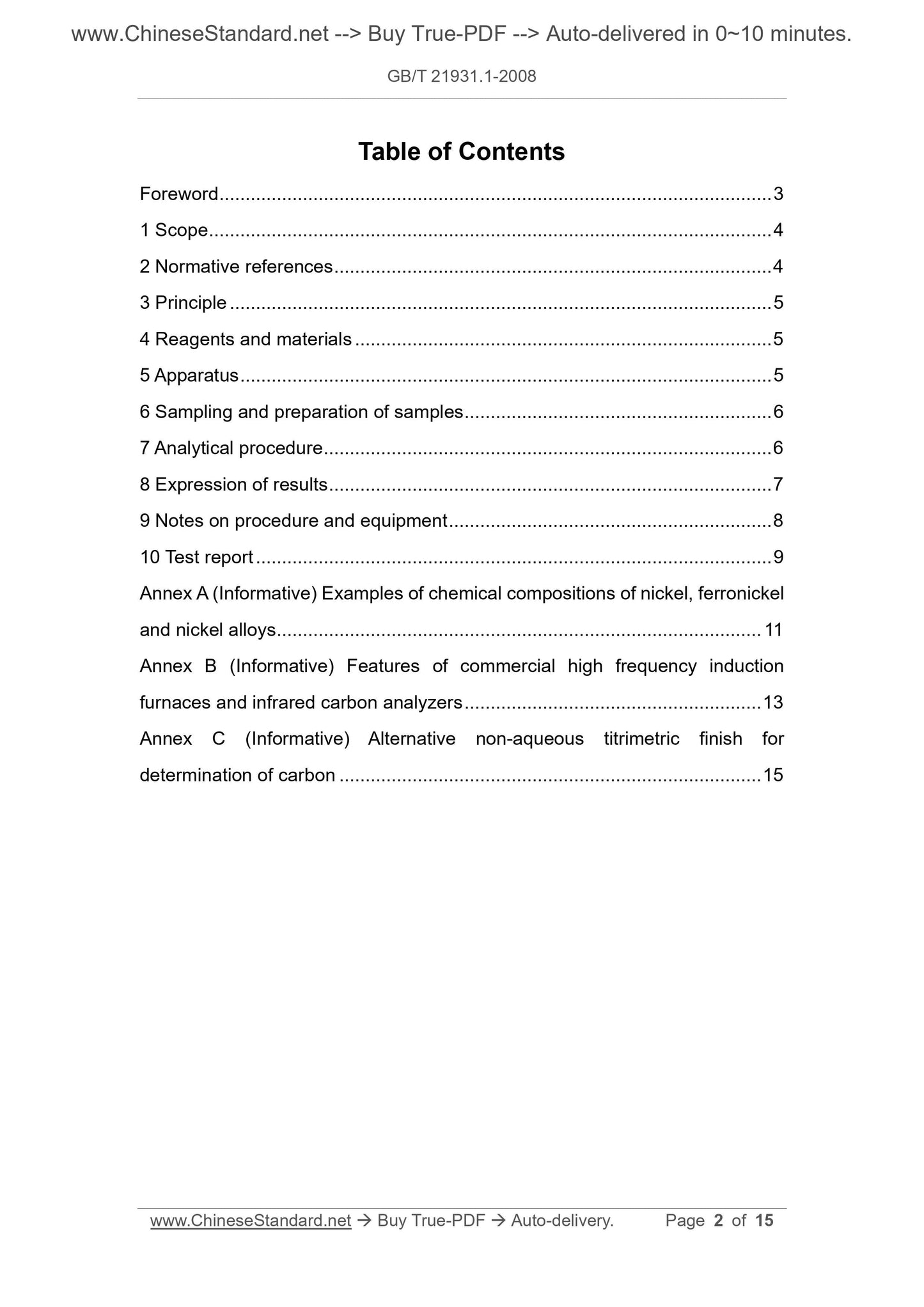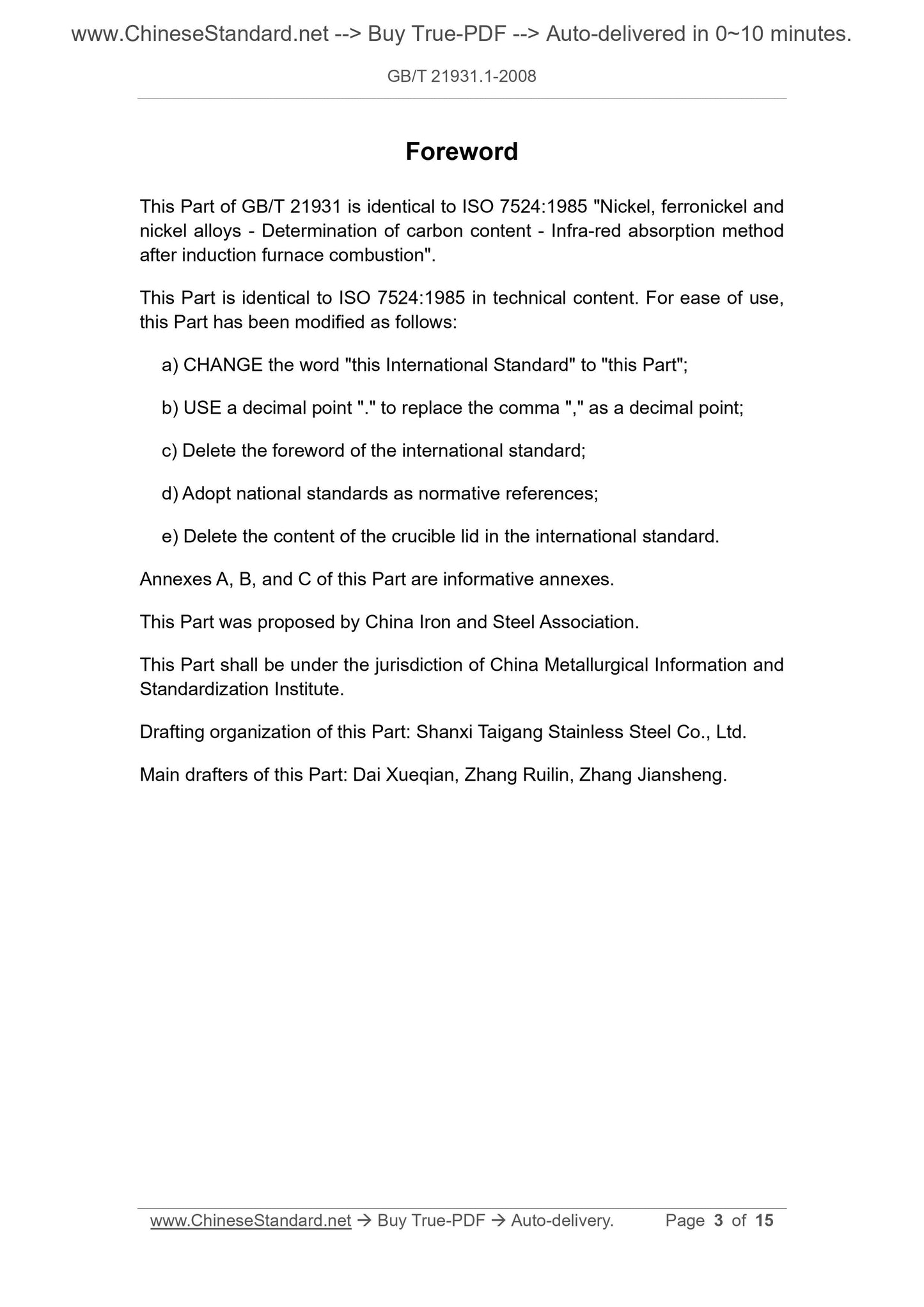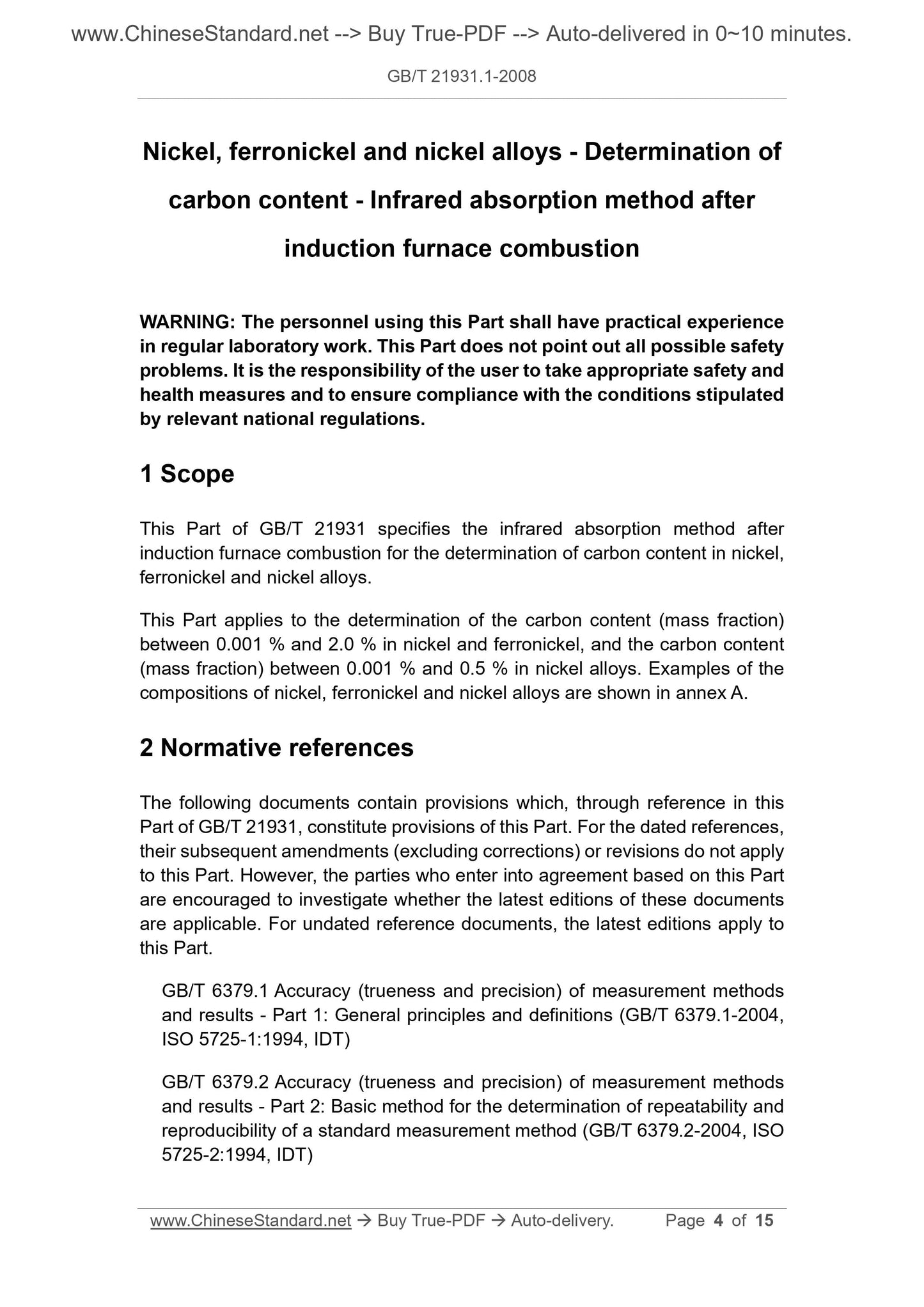1
/
de
4
PayPal, credit cards. Download editable-PDF and invoice in 1 second!
GB/T 21931.1-2008 English PDF (GBT21931.1-2008)
GB/T 21931.1-2008 English PDF (GBT21931.1-2008)
Prix habituel
$140.00 USD
Prix habituel
Prix promotionnel
$140.00 USD
Prix unitaire
/
par
Frais d'expédition calculés à l'étape de paiement.
Impossible de charger la disponibilité du service de retrait
Delivery: 3 seconds. Download true-PDF + Invoice.
Get QUOTATION in 1-minute: Click GB/T 21931.1-2008
Historical versions: GB/T 21931.1-2008
Preview True-PDF (Reload/Scroll if blank)
GB/T 21931.1-2008: Nickel, ferronickel and nickel alloys -- Determination of carbon content -- Infrared absorption method after induction furnace combustion
GB/T 21931.1-2008
Nickel, ferronickel and nickel alloys - Determination of carbon content - Infrared absorption method after induction furnace combustion
ICS 77.100
H11
National Standards of People's Republic of China
GB/T 21931.1-2008/ISO 7524.1985
Determination of carbon content of nickel, nickel-iron and nickel alloys
High frequency combustion infrared absorption method
(ISO 7524.1985, IDT)
2008-05-30 released
Implementation of.2008-12-01
General Administration of Quality Supervision, Inspection and Quarantine of the People's Republic of China
Issued by China National Standardization Administration
Preface
This part of GB/T 21931 is equivalent to ISO 7524.1985 "Determination of carbon content of nickel, nickel-iron and nickel alloys.
External Absorption Law.
The technical content of this part is exactly the same as ISO 7524.1985.For ease of use, this part has been modified as follows.
a) The term "this International Standard" is changed to "this Part";
b) Use a decimal point "." to replace the comma "," as a decimal point;
c) Delete the foreword of the international standard;
d) National standards are adopted for normative references;
e) The contents of the crucible cover in the international standard have been deleted.
Appendix A, Appendix B and Appendix C of this section are informative appendices.
This part was proposed by the China Iron and Steel Association.
This part is under the jurisdiction of the Metallurgical Industry Information Standards Institute.
Drafting organization of this section. Shanxi Taigang Stainless Steel Co., Ltd.
The main drafters of this section. Dai Xueqian, Zhang Ruilin, Zhang Jiansheng.
GB/T 21931.1-2008/ISO 7524.1985
Determination of carbon content of nickel, nickel-iron and nickel alloys
High frequency combustion infrared absorption method
Warning. The personnel using this section should have practical experience in formal laboratory work. This section does not point out all possible security issues.
The user is responsible for taking appropriate safety and health measures and ensuring compliance with the conditions stipulated by relevant national laws and regulations.
1 scope
This part of GB/T 21931 specifies the determination of the carbon content in nickel, nickel-iron and nickel alloys by the infrared absorption method after high-frequency induction combustion.
This section applies to the carbon content (mass fraction) in nickel and ferronickel for 0.001% to 2.0%, and the carbon content (mass fraction) in nickel alloys is
0.001% to 0.5% determination. Examples of the composition of nickel, nickel-iron and nickel alloys are shown in Appendix A.
2 Normative references
The clauses in the following documents have become clauses of this part by reference to this part of GB/T 21931.All dated quotations
All subsequent amendments (excluding errata content) or revisions do not apply to this section, however, it is encouraged to reach
The parties to the agreement study whether the latest versions of these documents can be used. For undated references, the latest version is applicable to this
section.
GB/T 63779.1 Measurement methods and accuracy of results (accuracy and precision) Part 1.General principles and definitions
(GB/T 6379.1-2004, ISO 5725-1..1994, IDT)
GB/T 63779.2 Accuracy of measurement methods and results (accuracy and precision) Part 2.Determine the repeatability of standard measurement methods
The basic method of performance and reproducibility (GB/T 6379.2-2004, ISO 5725-2.1994, IDT)
3 Principle
Place the sample, flux, and accelerator in a high-frequency induction furnace and burn it at a high temperature under oxygen flow. The carbon dioxide produced is carried by oxygen to
In the measuring chamber of the infrared detector, carbon dioxide absorbs infrared energy of a certain wavelength, and its absorption energy is proportional to the concentration of carbon. According to the detector
The measured value can determine the carbon content.
4 Reagents and materials
4.1 Oxygen, the purity is greater than 99.5%.
4.2 Caustic soda asbestos (or soda lime), particle size 0.7mm ~ 1.2mm (14 mesh ~ 22 mesh).
4.3 Magnesium perchlorate, particle size 0.7mm~1.2mm (14 mesh ~ 22 mesh).
4.4 Glass wool.
4.5 Crucible.
4.5.1 The size of the ceramic crucible should be accurate, so that the sample can fit in the induction coil of the furnace (see 9.1).
4.5.2 When the carbon content (mass fraction) is less than 0.01%, the crucible is burned in air or oxygen for no less than 1h in a furnace at 1,100°C.
Store in a desiccator or sealed container afterwards. A resistance furnace with a combustion tube can be used, with oxygen passing through the combustion tube.
4.6 Flux. low-carbon tin, copper plus tin or copper (see 9.2).
4.7 Accelerator. low-carbon copper, pure iron, tungsten or nickel (see 9.2).
4.8 Steel standard samples. carbon content (mass fraction) 0.01% to 2.5%.
GB/T 21931.1-2008/ISO 7524.1985
5 Instruments
High-frequency induction burner and infrared absorption carbon meter can be purchased from the manufacturer. The operation of the instrument is in accordance with the manufacturer's instructions. According to the system
Factory technical specifications require a pressure regulator to control the pressure of oxygen entering the furnace (usually 28kN/m2). See the characteristics of commodity instruments
Appendix B.
6 Take samples
6.1 The collection and preparation of laboratory samples shall be carried out in accordance with the agreed procedures or in accordance with relevant national standards.
6.2 Laboratory samples are generally granular, drill chips or milling chips, and no further processing is required.
6.3 If the laboratory sample is contaminated by grease during grinding or drilling, it should be cleaned with analytical pure acetone and dried in air.
6.4 If the laboratory sample has a large difference in particle size, the sample size should be obtained after reduction.
7 Analysis steps
Warning. The danger of this experiment is mainly the burning (burn) that easily occurs during the pre-firing and melting stages of the crucible. So it should be used from start to finish
Clamp the crucible and place the used crucible in a suitable container. The use of oxygen cylinders should comply with its usual safety measures. Local enrichment of oxygen can cause
Fire, so oxygen must be effectively discharged from the equipment during the combustion process.
7.1 The amount of sample
Weigh 1.0g sample to the nearest 0.0001g.
7.2 Blank test
According to the sample analysis method, add quantitative flux and accelerator. Perform at least three blank tests.
7.3 Preparation for analysis
7.3.1 Before calibrating and measuring the sample, the instrument must be checked and adjusted to ensure that the instrument is in a normal and stable working state, and determine the best analysis
condition.
7.3.2 After completing the blank calibration, the instrument automatically deducts the blank in the subsequent sample measurement.
7.4 Calibration
Use the standard sample in 4.8 to calibrate. Within the measurement range, select a standard sample with appropriate content to measure at least three times to perform system linearity
adjust. Then measure a series of standard samples, check the linear relationship after calibration, and if necessary, further calibrate the working curve.
7.5 Sample analysis
Place the weighed sample (7.1) in the crucible (4.5), and cover the appropriate amount of flux and accelerator (variety and amount of flux and accelerator)
It depends on the characteristics of the equipment and the...
Get QUOTATION in 1-minute: Click GB/T 21931.1-2008
Historical versions: GB/T 21931.1-2008
Preview True-PDF (Reload/Scroll if blank)
GB/T 21931.1-2008: Nickel, ferronickel and nickel alloys -- Determination of carbon content -- Infrared absorption method after induction furnace combustion
GB/T 21931.1-2008
Nickel, ferronickel and nickel alloys - Determination of carbon content - Infrared absorption method after induction furnace combustion
ICS 77.100
H11
National Standards of People's Republic of China
GB/T 21931.1-2008/ISO 7524.1985
Determination of carbon content of nickel, nickel-iron and nickel alloys
High frequency combustion infrared absorption method
(ISO 7524.1985, IDT)
2008-05-30 released
Implementation of.2008-12-01
General Administration of Quality Supervision, Inspection and Quarantine of the People's Republic of China
Issued by China National Standardization Administration
Preface
This part of GB/T 21931 is equivalent to ISO 7524.1985 "Determination of carbon content of nickel, nickel-iron and nickel alloys.
External Absorption Law.
The technical content of this part is exactly the same as ISO 7524.1985.For ease of use, this part has been modified as follows.
a) The term "this International Standard" is changed to "this Part";
b) Use a decimal point "." to replace the comma "," as a decimal point;
c) Delete the foreword of the international standard;
d) National standards are adopted for normative references;
e) The contents of the crucible cover in the international standard have been deleted.
Appendix A, Appendix B and Appendix C of this section are informative appendices.
This part was proposed by the China Iron and Steel Association.
This part is under the jurisdiction of the Metallurgical Industry Information Standards Institute.
Drafting organization of this section. Shanxi Taigang Stainless Steel Co., Ltd.
The main drafters of this section. Dai Xueqian, Zhang Ruilin, Zhang Jiansheng.
GB/T 21931.1-2008/ISO 7524.1985
Determination of carbon content of nickel, nickel-iron and nickel alloys
High frequency combustion infrared absorption method
Warning. The personnel using this section should have practical experience in formal laboratory work. This section does not point out all possible security issues.
The user is responsible for taking appropriate safety and health measures and ensuring compliance with the conditions stipulated by relevant national laws and regulations.
1 scope
This part of GB/T 21931 specifies the determination of the carbon content in nickel, nickel-iron and nickel alloys by the infrared absorption method after high-frequency induction combustion.
This section applies to the carbon content (mass fraction) in nickel and ferronickel for 0.001% to 2.0%, and the carbon content (mass fraction) in nickel alloys is
0.001% to 0.5% determination. Examples of the composition of nickel, nickel-iron and nickel alloys are shown in Appendix A.
2 Normative references
The clauses in the following documents have become clauses of this part by reference to this part of GB/T 21931.All dated quotations
All subsequent amendments (excluding errata content) or revisions do not apply to this section, however, it is encouraged to reach
The parties to the agreement study whether the latest versions of these documents can be used. For undated references, the latest version is applicable to this
section.
GB/T 63779.1 Measurement methods and accuracy of results (accuracy and precision) Part 1.General principles and definitions
(GB/T 6379.1-2004, ISO 5725-1..1994, IDT)
GB/T 63779.2 Accuracy of measurement methods and results (accuracy and precision) Part 2.Determine the repeatability of standard measurement methods
The basic method of performance and reproducibility (GB/T 6379.2-2004, ISO 5725-2.1994, IDT)
3 Principle
Place the sample, flux, and accelerator in a high-frequency induction furnace and burn it at a high temperature under oxygen flow. The carbon dioxide produced is carried by oxygen to
In the measuring chamber of the infrared detector, carbon dioxide absorbs infrared energy of a certain wavelength, and its absorption energy is proportional to the concentration of carbon. According to the detector
The measured value can determine the carbon content.
4 Reagents and materials
4.1 Oxygen, the purity is greater than 99.5%.
4.2 Caustic soda asbestos (or soda lime), particle size 0.7mm ~ 1.2mm (14 mesh ~ 22 mesh).
4.3 Magnesium perchlorate, particle size 0.7mm~1.2mm (14 mesh ~ 22 mesh).
4.4 Glass wool.
4.5 Crucible.
4.5.1 The size of the ceramic crucible should be accurate, so that the sample can fit in the induction coil of the furnace (see 9.1).
4.5.2 When the carbon content (mass fraction) is less than 0.01%, the crucible is burned in air or oxygen for no less than 1h in a furnace at 1,100°C.
Store in a desiccator or sealed container afterwards. A resistance furnace with a combustion tube can be used, with oxygen passing through the combustion tube.
4.6 Flux. low-carbon tin, copper plus tin or copper (see 9.2).
4.7 Accelerator. low-carbon copper, pure iron, tungsten or nickel (see 9.2).
4.8 Steel standard samples. carbon content (mass fraction) 0.01% to 2.5%.
GB/T 21931.1-2008/ISO 7524.1985
5 Instruments
High-frequency induction burner and infrared absorption carbon meter can be purchased from the manufacturer. The operation of the instrument is in accordance with the manufacturer's instructions. According to the system
Factory technical specifications require a pressure regulator to control the pressure of oxygen entering the furnace (usually 28kN/m2). See the characteristics of commodity instruments
Appendix B.
6 Take samples
6.1 The collection and preparation of laboratory samples shall be carried out in accordance with the agreed procedures or in accordance with relevant national standards.
6.2 Laboratory samples are generally granular, drill chips or milling chips, and no further processing is required.
6.3 If the laboratory sample is contaminated by grease during grinding or drilling, it should be cleaned with analytical pure acetone and dried in air.
6.4 If the laboratory sample has a large difference in particle size, the sample size should be obtained after reduction.
7 Analysis steps
Warning. The danger of this experiment is mainly the burning (burn) that easily occurs during the pre-firing and melting stages of the crucible. So it should be used from start to finish
Clamp the crucible and place the used crucible in a suitable container. The use of oxygen cylinders should comply with its usual safety measures. Local enrichment of oxygen can cause
Fire, so oxygen must be effectively discharged from the equipment during the combustion process.
7.1 The amount of sample
Weigh 1.0g sample to the nearest 0.0001g.
7.2 Blank test
According to the sample analysis method, add quantitative flux and accelerator. Perform at least three blank tests.
7.3 Preparation for analysis
7.3.1 Before calibrating and measuring the sample, the instrument must be checked and adjusted to ensure that the instrument is in a normal and stable working state, and determine the best analysis
condition.
7.3.2 After completing the blank calibration, the instrument automatically deducts the blank in the subsequent sample measurement.
7.4 Calibration
Use the standard sample in 4.8 to calibrate. Within the measurement range, select a standard sample with appropriate content to measure at least three times to perform system linearity
adjust. Then measure a series of standard samples, check the linear relationship after calibration, and if necessary, further calibrate the working curve.
7.5 Sample analysis
Place the weighed sample (7.1) in the crucible (4.5), and cover the appropriate amount of flux and accelerator (variety and amount of flux and accelerator)
It depends on the characteristics of the equipment and the...
Share








